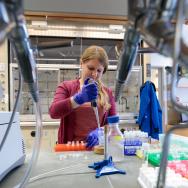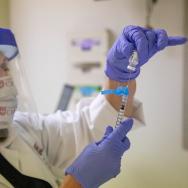While the world has welcomed the news of multiple vaccines against COVID-19, the search for effective treatments for those who contract the virus is ongoing. Now scientists are looking to what might seem to be an unlikely source: the South American llama.
Researchers are using the ultra-bright X-rays of the Advanced Photon Source, an accelerator at Argonne National Laboratory, to help turn naturally generated llama antibodies into potentially effective therapies against COVID-19.
“We have received more than 50 llama antibodies with several proteins of SARS-CoV-2,” said University of Chicago professor and senior Argonne scientist Andrzej Joachimiak, director of the Structural Biology Center at the Advanced Photon Source and co-director of the Center for Structural Genomics of Infectious Diseases.
These antibodies are part of ongoing collaborations with several partners, including researchers at the National Institutes of Health and the National Institute of Arthritis and Musculoskeletal and Skin Diseases, Joachimiak said, and will be analyzed to see if they combat the virus’s infectivity.

Camelid cures
While it may seem surprising that scientists are turning to llamas, there’s a very good reason for it.
Llamas belong to a group of mammals called camelids, a group that also includes camels and alpacas. Thanks to a quirk of nature, camelids produce a unique type of antibody against disease. These antibodies, often referred to as nanobodies, are about half the size of the antibodies produced by humans. They’re also remarkably stable and easy for scientists to manipulate.
This genetic quirk, which causes camelids such as llamas to produce not only heavier antibodies with multiple protein chains, but these smaller ones with single protein chains, was discovered by accident in the late 1980s by scientists in Belgium. Since then, scientists have worked with camelid nanobodies to create treatments against several diseases with great success.
“Llamas generate these nanobodies naturally in high yields, and they fit into the pockets on the surface of proteins that larger-size antibodies can’t access,” said Jason McLellan, an associate professor at the University of Texas at Austin.
McLellan has years of experience working with camelid nanobodies. He and his graduate student Daniel Wrapp, along with Xavier Saelens’ group in Belgium, have isolated nanobodies that have proven effective against respiratory syncytial virus and two coronaviruses: severe acute respiratory syndrome (SARS) and Middle East respiratory syndrome (MERS).
When the genetic sequence of SARS-CoV-2 was released in January of 2020, McLellan, Wrapp and Saelens worked quickly to test whether any of the antibodies that they had previously isolated against the original SARS-CoV (taken from a Belgian llama named Winter) could also bind and neutralize the virus. They discovered that one of these nanobodies, which they had characterized using the Structural Biology Center beamlines at the Advanced Photon Source, might be effective against SARS-CoV-2. McLellan said this nanobody—called VHH72—is now under development as a treatment for COVID-19. He and Wrapp received a 2020 Golden Goose Award for this research.
McLellan will tell you that while his results were good, his hopes were a little higher.
“We were seeking one potent antibody that neutralized all coronaviruses,” he said. “We immunized Winter hoping to elicit that one nanobody. And maybe we elicited it, but we didn’t isolate it.”
Isolating these tiny nanobodies is tricky, since the body generates an enormous number of them and only a small fraction is intended to fight a particular virus. That’s exactly the problem that Yi Shi, professor of cell biology at the University of Pittsburgh, is trying to fix.
Assists from Wally and Winter
In a paper published in Science, Shi and his colleagues unveiled a new advanced mass spectroscopy method of extracting those nanobodies from samples of llama blood. According to Shi and research assistant Yufei Xiang, the paper’s lead author, the result is a large set of nanobodies that bind well to the SARS-CoV-2 virus.

“This is thousands of times better than the current technology, specifically in its selecting properties,” Shi said. “We want nanobodies that bind tightly to SARS-CoV-2, and with this method we can get a drug-quality nanobody that is up to 10,000 times more potent.”
As with McLellan’s research, Shi’s experiment began with a llama, this one named Wally because he resembles (and therefore shares a name with) his black Labrador. The team immunized Wally against SARS-CoV-2, waiting two months for nanobodies to be generated, and then Xiang used their new method to analyze the nanobodies, identify and quantify them. They ended up with 10 million nanobody sequences.
These nanobodies can sit at room temperature for six weeks, and are small enough that they can be aerosolized, meaning they can be inhaled directly to the lungs instead of moving through the bloodstream.
To confirm the nanobodies’ effectiveness, Cheng Zhang, assistant professor at the University of Pittsburgh, determined structures of the nanobodies bound to the SARS-CoV-2 virus at the National Institute of General Medical Sciences and National Cancer Institute Structural Biology Facility at the Advanced Photon Source.
“With this method we can discover thousands of distinct, ultrahigh-affinity nanobodies for specific antigen binding,” Shi said. “These nanobodies may or may not provide a treatment for COVID-19, but the technology used to isolate them will be important in the future.”
Only time will tell whether the nanobodies will translate into effective treatments against COVID-19.
Most recently, a team of scientists led by the University of Bonn in Germany reported newly discovered nanobodies that bind to SARS-CoV-2 and may prevent what is called “mutational escape.” That’s the ability of a virus to avoid immune responses by mutating, and a treatment that prevents the virus from doing so would guard against re-infection.
This research team combined several nanobodies into molecules that attack different parts of the virus simultaneously, helping to prevent virus mutations from reducing therapeutic effectiveness. These nanobodies were taken from a llama and an alpaca immunized against the SARS-CoV-2 virus, and out of several million candidates they ended up with four molecules that proved to be effective.
Ian Wilson, professor of structural biology at the Scripps Research Institute in California, led the team that conducted X-ray diffraction studies at GM/CA at the Advanced Photon Source to determine structures of these molecules bound to the virus. (Researchers at the APS do not work with the live virus, but with crystals grown from simulated proteins.)
“From crystal structures determined from data collected at APS and the Stanford Synchrotron Radiation Lightsource, we were able to identify the binding sites of the nanobodies on the SARS-CoV-2 receptor binding domain,” Wilson said. “The X-ray structural information, combined with cryo-electron microscopy data, was used to help design even more potent multivalent antibodies to prevent COVID-19 infection. The X-ray structural work was greatly facilitated by immediate access to the Advanced Photon Source.”
Only time (and further tests) will tell whether the various nanobodies will translate into effective treatments against COVID-19. But if they do, we’ll have the lovable llama to thank for it.
The Advanced Photon Source is a U.S. Department of Energy Office of Science User Facility operated by Argonne National Laboratory. Additional funding for beamlines used for COVID-19 research at the APS is provided by the National Institutes of Health (NIH) and by DOE Office of Science Biological and Environmental Research. The APS operated for 10 percent more hours in 2020 than usual to support COVID-19 research, with the additional time supported by the DOE Office of Science through the National Virtual Biotechnology Laboratory, a consortium of DOE national laboratories focused on response to COVID-19 with funding provided by the Coronavirus CARES Act.
–Adapted from an article first published by Argonne National Laboratory.









